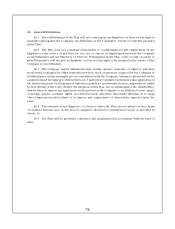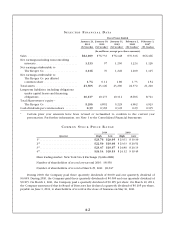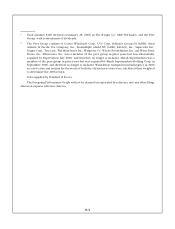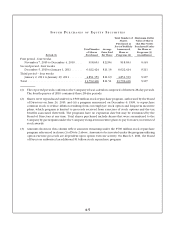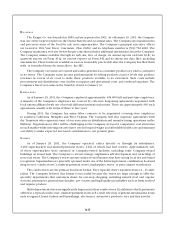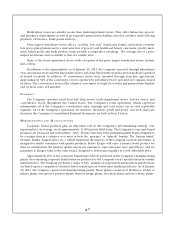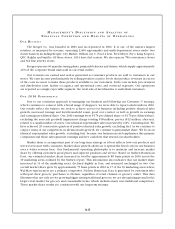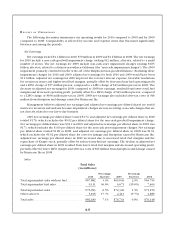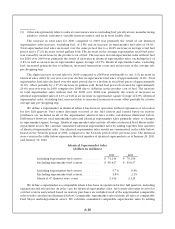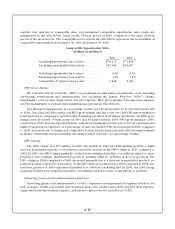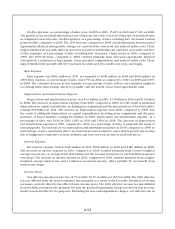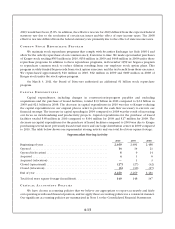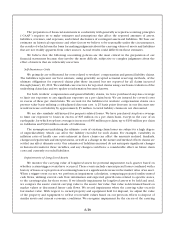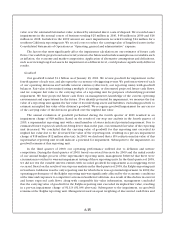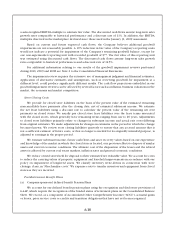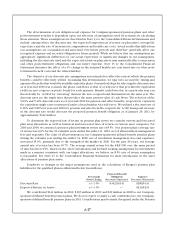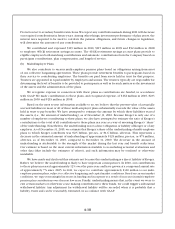Kroger 2010 Annual Report Download - page 88
Download and view the complete annual report
Please find page 88 of the 2010 Kroger annual report below. You can navigate through the pages in the report by either clicking on the pages listed below, or by using the keyword search tool below to find specific information within the annual report.
A-8
MA N A G E M E N T ’S DI S C U S S I O N A N D AN A L Y S I S O F
FI N A N C I A L CO N D I T I O N A N D RE S U L T S O F OP E R A T I O N S
OUR BUSINESS
The Kroger Co. was founded in 1883 and incorporated in 1902. It is one of the nation’s largest
retailers, as measured by revenue, operating 2,460 supermarket and multi-department stores under two
dozen banners including Kroger, City Market, Dillons, Jay C, Food 4 Less, Fred Meyer, Fry’s, King Soopers,
QFC, Ralphs and Smith’s. Of these stores, 1,014 have fuel centers. We also operate 784 convenience stores
and 361 fine jewelry stores.
Kroger operates 40 manufacturing plants, primarily bakeries and dairies, which supply approximately
40% of the corporate brand units sold in our retail outlets.
Our revenues are earned and cash is generated as consumer products are sold to customers in our
stores. We earn income predominately by selling products at price levels that produce revenues in excess
of the costs we incur to make these products available to our customers. Such costs include procurement
and distribution costs, facility occupancy and operational costs, and overhead expenses. Our operations
are reported as a single reportable segment: the retail sale of merchandise to individual customers.
OUR 2010 PERFORMANCE
Due to our consistent approach to managing our business and following our Customer 1st strategy,
which continues to connect with a broad range of shoppers, we were able to report solid results in 2010.
Our results reflect the balance we seek to achieve across our business including positive identical sales
growth, increased tonnage and loyal household count, good cost control, as well as growth in earnings
and earnings per diluted share. Our 2010 earnings were $1.74 per diluted share or $1.76 per diluted share,
excluding the non-cash goodwill impairment charge totaling $18 million, pre-tax ($12 million, after-tax),
related to a small number of stores. Our identical supermarket sales increased by 2.8%, excluding fuel. We
have achieved 29 consecutive quarters of positive identical sales growth, excluding fuel. As we continue to
outpace many of our competitors on identical sales growth, we continue to gain market share. We focus on
identical supermarket sales growth, excluding fuel, because our business model emphasizes this primary
component and those sales generate earnings and free cash flow that reward our shareholders.
Market share is an important part of our long-term strategy as it best reflects how our products and
services resonate with customers. Market share growth allows us to spread the fixed costs in our business
over a wider revenue base. Our fundamental operating philosophy is to maintain and increase market
share by offering customers good prices and superior products and service. Based on Nielsen Homescan
Data, our estimated market share increased in total by approximately 80 basis points in 2010 across the
19 marketing areas outlined by the Nielsen report. This information also indicates that our market share
increased in 13 of the marketing areas, declined slightly in four, and remained unchanged in two. Our
overall market share grew by approximately 75 basis points in 2010 in 17 of the 19 marketing areas where
Wal-Mart supercenters are a primary competitor. Nielsen Homescan Data is generated by customers who
self-report their grocery purchases to Nielsen, regardless of retail channel or grocery outlet. This data
illustrates that not only are we growing bigger among traditional grocers, we are also gaining ground in the
larger retail market for grocery and consumable items, which includes many non-traditional competitors.
These market share results are consistent with our long-term strategy.


